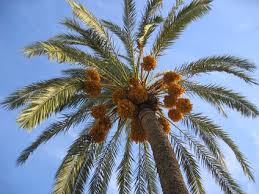Another cold hardy palm (down to -15ºC) is
Jubaea chilensis (Chilean Wine Palm), that produces edible fruits (Coquito nuts). The tree is also an endangered species.
_nuytsia_pix.jpg/220px-Jubaea_chilensis_(Fruit_and_nut)_nuytsia_pix.jpg) |
| Jubaea chilensis fruits |
Butia capitata (Jelly Palm) is another cold hardy palm (down to -10ºC), which has strong tasting edible fruits. This one has been cultivated in Virginia, US.
 |
| Butia capitata fruits |
Ensete (
Ensete ventricosum) is a highly cultivated edible in Africa (from Ethiopia to Congo). Its a banana relative. A few plants produce enough starch for a family (from its trunk). It can probably stand a few minor frosts, but it is better to dig it up and overwinter ensete inside a greenhouse. It probably grows permanently outdoors only in zone 10. Ensete is quite drought tolerant and high yielding, hence it has a special permacultural interest to me. Seeds can sometimes be found in websites selling palm trees. I have tried to germinate their seeds, but so far to no success.
 |
Ensete, one of Ethiopia staple starch foods
|
Palm dates are another important cultivate species. Widely grown in the Middle East and North Africa, and it could probably be attempted in Mediterranean Europe. It is reported to be hardy to -10ºC. I don't understand why it isn't more widely cultivated when it is so well adapted to the dry and hot climates of south Europe. Dates provide a good staple food, that is perennial and highly drought tolerant. So far I haven't had any success in germinating dates from seed from store bought fruits. It probably requires a sandy soil, with a very warm temperature.
 |
| Dates are one the best choices for a food forest project in a climate with dry and hot summers. |
I will leave the banana fruits for another future article!
_nuytsia_pix.jpg/220px-Jubaea_chilensis_(Fruit_and_nut)_nuytsia_pix.jpg)



No comments:
Post a Comment